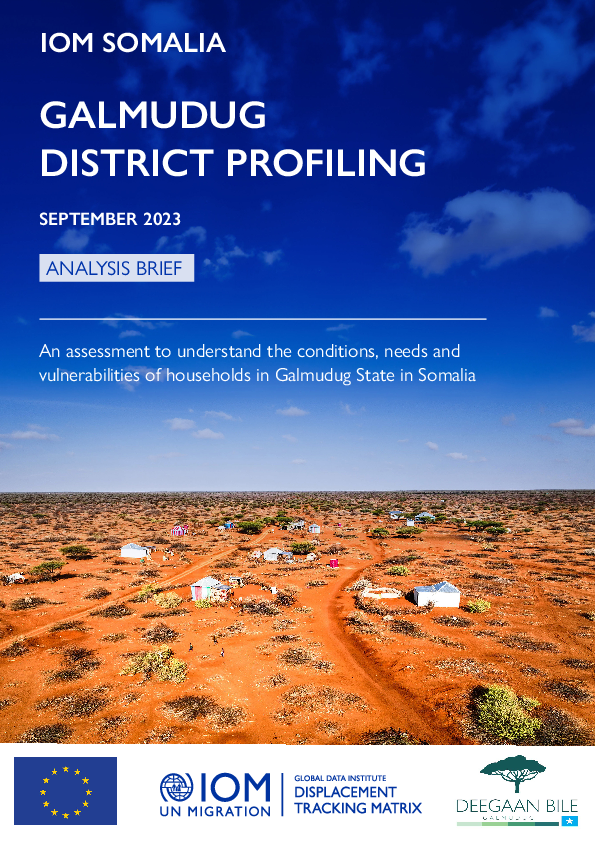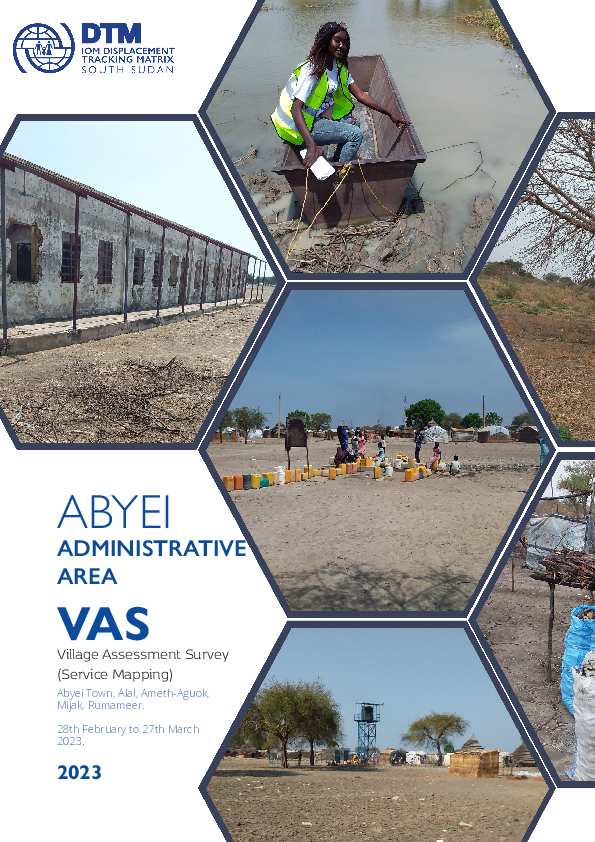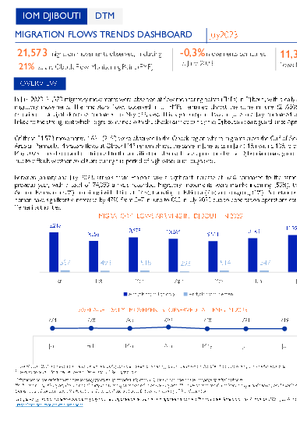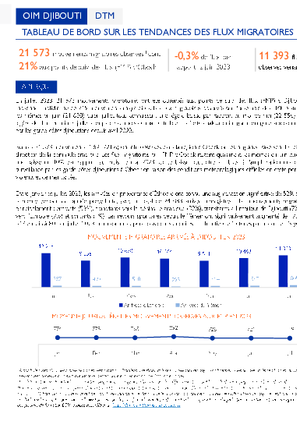-
Countries
-
Data and Analysis
-
Special Focus
-
Crisis Responses
Assessment Report
Since March 2022, IOM Displacement Tracking Matrix (DTM) regularly collects individual surveys in countries neighbouring to Ukraine with persons who cross back, with the aim to improve the understanding of their profiles, displacement patterns, intentions and needs. The survey is deployed in 5 countries neighbouring Ukraine – Hungary, Poland, the Republic of Moldova, Romania, and Slovakia.
Key Findings
- Between April and June 2023, there are more “short-time visitors” (47%) than “prospective returnees” (42%) among Ukrainians crossing back from neighbouring countries, while a minority (11%) is unsure on the length of their visit. Women (91% of the sample) more frequently intend to pay a short visit than men (47% vs 42%). Prospective returnees are older than short-time visitors by 8 years on average (47 years versus 39 years old).
- For both, short-time visitors and prospective returnees, reasons related to the desire to visit or reunite with family members are prevalent. Moreover, one third of short-time visitors mentioned the need to go to the doctor’s, have a surgery or take a specialist exam, and another third aimed at obtaining or renewing identity documents (biometric passport, diplomas, licenses).
- 52% of Ukrainians interviewed stayed in one of the neighbouring countries, for an average period of 10 months before crossing back. The rest stayed mainly in Germany, Czechia, and the UK.
- The period since initial displacement is longer for short-time visitors (407 days), who also have already crossed in and out of Ukraine twice or more since February 2022 in most cases (54%). Prospective returnees (220 days) have spent less time abroad on average and have less frequently travelled in and out of Ukraine before returning than short-time visitors (55% only once or zero).
- The Top 5 needs are: financial support (20%), health support (17%), medicines (12%), food supply (11%) and general information (10%). Short-time visitors report a higher level of needs overall (linked to issues that they aimed to solve during the visit in Ukraine) than prospective returnees. The latter report no needs in more than half (55%) of the cases, as they may be already more focused on the conditions of return rather than on what was not achieved successfully abroad.
- Ukrainians, transiting from Latvia through the Russian Federation to reach eastern areas of Ukraine have a different profile than those crossing from neighbouring countries into western Ukraine. Most originate from areas which are temporary not under Ukraine’s government control in four oblasts – Donetska, Luhanska, Khersonska and Zaporizka. Among them, there are more prospective returnees than short-time visitors, with the desire to reunite with their family members, and with a widespread need of more information about Ukraine and recent developments on the grounds than anything else.
- TCNs have often spent in Ukraine long periods (even more than 5 years) before being displaced abroad because of the military invasion. Most of those interviewed when crossing back from neighbouring countries plan to resume their studies or take exams to avoid interruption of their education cycle and career.
- The profiles and needs expressed by Ukrainians crossing back from neighbouring countries and surveyed between April and June 2023 mostly match with those of the actual returnees from abroad surveyed in Ukraine in May 2023.
- Trends in terms of profiles, intentions and needs from Ukrainians crossing back from between April and June 2023 are in line with what observed in the previous reporting period (January-March 2023), with small variations (+/-2%) between the two consecutive periods on the main quantitative findings

Contact
DTM Thailand, dtmthailand@iom.int
Language
English
Location
Thailand
Period Covered
Jan 01 2023
Jun 30 2023
Activity
- Survey
- Flow Monitoring Survey
- Flow Monitoring
To gain a better understanding of the mobility dynamics and vulnerabilities of Myanmar nationals entering Thailand, IOM Thailand’s initiated flow monitoring activities at key points of entry (POEs) in Tak and Ranong provinces at the beginning of 2023 using IOM Displacement Tracking Matrix (DTM) tools. Flow monitoring is designed to track the scale and characteristics of human mobility along the border, including the volume, intended destinations, reasons for movement, intended lengths of stay, and expectations about work sectors and conditions. The activity provides critical insights into current mobility dynamics in the context of the socio-economic and security situation in Myanmar following the military takeover in February 2021.
FMC and FMS are conducted simultaneously at each point for one week every month. Tak and Ranong were chosen due to pre-existing information indicating that the two provinces experience a substantial volume of entries.
From January to June 2023, IOM MDRU interviewed a total of 3,091 incoming Myanmar nationals to Thailand, with 1,179 interviewed in Tak province and 1,912 in Ranong province.

Contact
DTM Ethiopia, DTMEthiopia@iom.int
Language
English
Location
Ethiopia
Period Covered
Nov 25 2022
Jun 29 2023
Activity
- Mobility Tracking
- Site Assessment
- Village Assessment
Between April and June 2023, IOM DTM deployed Site Assessment (SA) Round 33 and Village Assessment Survey (VAS) Round 16, carrying out a multisectoral location assessment in Tigray region, and a figure update in selected high mobility locations across the rest of Ethiopia. The November 2022 - January 2023 data (Round 32 for SA and Round 15 for VAS) was compiled with the April - June 2023 data (Round 33 for SA and Round 16 for VAS) to consolidate national IDP and returning IDP figures updated to June 2023. The locations assessed during both rounds of data collection are not duplicated in the consolidated figures.
As of June 2023, 4,385,789 IDPs (872,483 IDP households) were internally displaced across 3,393 assessed, accessible sites in Ethiopia. Conflict is the primary cause of displacement and displaced 2.9 million IDPs (66.41%), followed by drought which displaced 810,855 IDPs (18.49%). Somali region hosts the highest number of IDPs primarily displaced by drought nationwide (542,807 individuals or 66.94% of national drought caseload), while Tigray region hosts the highest number of IDPs primarily displaced by conflict nationwide (1,011,636 individuals or 34.73% of national conflict caseload).
As of June 2023, IOM DTM estimated 3,238,803 returning IDPs (737,873 returning IDP households) across 2,754 assessed, accessible villages in Ethiopia. The highest returning IDP caseloads nationwide were in the regions of Amhara (1,422,074 returning IDPs, 43.91%), Tigray (1,256,297 returning IDPs, 38.79%) and Afar (194,968 returning IDPs, 6.02%).

Contact
DTM Somalia, IOMSomaliaDTM@iom.int
Language
English
Location
Somalia
Period Covered
Apr 01 2023
Jun 01 2025
Activity
- Community Perception
- Mobility Tracking
In 2023, DTM Somalia implemented the Galmudug District Profiling houssehold assessment. The aim of the assessment is to strengthen the evidence base on the conditions, needs and vulnerabilities of households in accessible areas of Galmudug state. A total of 1,560 surveys were conducted.
The survey tool was co-designed with IOM's Community Stabilizaton and Migration, Environment and Climate Change units, with a focus on livelihoods; food; pastoralism and farming; environmental degradation and adaptation; services; water; social cohesion; conflict and security; information sources; and movement intentions. Findings are presented at district level, with key differences according to the mobility status of households, as well as gender of the head of household, also displayed.
If you have any questions about this assessment, please contact the DTM Somalia team at: iomsomaliadtm@iom.int
This assessment was implemented with support from the European Union.

Contact
SouthSudanDTM@iom.int
Language
English
Location
South Sudan
Period Covered
Feb 28 2023
Mar 27 2023
Activity
- Other
- Survey
IOM’s Displacement Tracking Matrix (DTM) conducted the Village Assessment Survey (VAS) to facilitate planning for transition and recovery programs. Its main objectives are to map the availability of basic needs, services, and infrastructure and to identify priority areas for intervention within selected counties in South Sudan.
This Abyei Administrative Area Village Assessment Survey covers a period from 28 February to 27 March 2023. The survey team mapped 393 facilities, encompassing 19 administrative buildings, 9 markets, 28 religious structures, 3 bus stations, and 264 water points. Notably, educational and healthcare facilities were identified as well, with 49 education facilities and 24 health facilities marked.

Contact
DTMUkraine@iom.int
Language
English
Location
Ukraine
Snapshot Date
Jul 31 2023
Activity
- Baseline Assessment
Базова територіальна оцінка зареєстрованих ВПО надає детальні дані щодо кількості та географічного розташування офіційно зареєстрованих внутрішньо переміщених осіб (ВПО). У звіті оцінено присутність зареєстрованих ВПО на рівні громад, а також відображено на мапі зафіксовані зміни, що відбулися з попереднього раунду. У раунді 26 представлені дані щодо кількості зареєстрованих ВПО із розподілом за статтю, віком та визнаним державою статусом особи з інвалідністю1.
Дані, зібрані для раунду 26 базового територіального оцінювання, відображають актуальні цифри місцевого адміністративного реєстру ВПО станом на 31 липня 2023 року, що складає 3 677 601 зареєстрованих ВПО. Дані щодо кількості зареєстрованих ВПО було зібрано для 1 039 громад (78% усіх охоплених громад на підконтрольних українському уряду територіях). Дані з розподілом за віком, статтю та статусом особи з інвалідністю було надано для приблизно 76% охоплених адміністративно-територіальних одиниць.
Для цілей цього оцінювання МОМ визначає ВПО як осіб, які офіційно зареєстровані як такі, що залишили своє звичне місце проживання через нинішню війну в Україні.

Contact
iombeirut@iom.int
Language
English
Location
Lebanon
Period Covered
Apr 01 2023
Jun 30 2023
Activity
- Migrants presence
- Mobility Tracking
- Baseline Assessment
This report presents the findings of the Migrant Presence Monitoring (MPM) data collection exercise conducted by IOM in Lebanon from April to June 2023, covering all districts. The MPM is an annual assessment that aims to determine the number of migrants present in different areas of Lebanon to support humanitarian assistance and planning efforts. To ensure accurate data, the MPM relies on key informants (KIs), such as representatives from migrant communities, local leaders (mukhtars), and municipal officials. This year, recruitment agencies were also included as KIs to enhance data reliability in their respective areas. The assessment focuses on small areas to gather detailed and precise information. It not only categorizes migrants by nationality, sex, and age but also considers their living situations, distinguishing between “live-in” and “live-out” migrants. Overall, the MPM provides valuable insights into the migrant population in Lebanon, contributing to informed decision-making and effective support for those in need.
The information from IOM-MPM's findings, complementary to data from past assessments, aims to enable partners across the international community and Lebanese partners to have access to an evidence base on migrant presence, to support well-informed, targeted, and coordinated response. The complementary evidence generated from the MPM exercise also serves as a baseline and tertiary source for triangulation for other data collection exercises. For example, MPM data was used to develop of a sampling frame of migrants for the Multi-Sectorial Needs Assessment (MSNA) 2021, 2022 and 2023 exercises led by the Humanitarian Country Team (HCT).
The MPM assessment follows the methodology of IOM’s global Displacement Tracking Matrix (DTM) Mobility Tracking component. Tailored to the operational context in Lebanon, the MPM assessment analyzes data to provide multi-layered information on the presence and mobility of migrants. This assessment aims to complement existing data collection exercises and it is implemented in coordination with key actors to maximize synergies, interoperability and avoid duplication.

Contact
DTM Djibouti, DTMDjibouti@iom.int
Language
English
Location
Djibouti
Period Covered
Jul 01 2023
Jul 31 2023
Activity
- Flow Monitoring
In July 2023, 21,573 migratory movements were observed at flow monitoring points (FMPs) in Djibouti, with a daily average of 719 migratory movements. The migratory flows observed in all FMPs remained almost the same in June (21,630) as in July, all experiencing a slight decrease compared to May (22,556). This slight drop in flows in June and July compared to May remains linked to the strong heat which reigns combined with the checks carried out by the Djiboutian coast guard since April 2023.
Of these 21,573 movements, 4,621 (21%) were observed in the Obock region where migrants cross the Gulf of Aden towards the Arabian Peninsula. Migratory flows at Obock FMP remain almost the same in June as as in July (-1%) with a 10% drop compared to May 2023. This drop can be attributed to the amplification of surveillance operations by the Djiboutian coast guards in Obock and due to difficult weather conditions during this period of high winds and rough seas.
Between January and July 2023, arrivals from Ethiopia saw a significant increase of 52% compared to the same period of the previous year, with a total of 74,083 arrivals recorded. Migratory movements were mainly: incoming (53%), transiting to the Arabian Peninsula (32%), transiting inside Djibouti (7%), transiting to Ethiopia (7%) and outgoing (1%) . Spontaneous returns from Yemen have significantly increased by 47%, from 547 in June to 805 in July 2023 due to deportation operations carried out by the Yemeni authorities.

Contact
DTM Djibouti, DTMDjibouti@iom.int
Language
French
Location
Djibouti
Period Covered
Jul 01 2023
Jul 31 2023
Activity
- Flow Monitoring
En juillet 2023, 21 573 mouvements migratoires ont été observés aux points de suivi des flux (FMP) à Djibouti, avec une moyenne quotidienne de 719 mouvements migratoires. Les flux migratoires observés sur l'ensemble des FMP restent quasiment les mêmes en juin (21 630) qu’en juillet tous connaissant une légère baisse par rapport au moi de mai (22 556). Cette baisse légère des flux en juin et juillet comparée au mois de mai reste liée à la forte chaleur qui règne conjuguée aux contrôles effectués par les garde-côtes djiboutiens depuis avril 2023.
Sur ces 21 573 mouvements, 4 621 (21%) ont été observés dans la région d'Obock où les migrants traversent le golfe d'Aden en direction de la péninsule arabique. Les flux migratoires aux FMP d'Obock restent quasiment les mêmes en juin qu’en juillet avec une baisse de 10% par rapport au mois de mai 2023. Cette baisse peut être attribuée à l'amplification des opérations de surveillance par les garde-côtes djiboutiens à Obock en raison des conditions météorologiques difficiles en cette période de vents violents et de mer agitée.
Entre janvier et juillet 2023, les arrivées en provenance d'Éthiopie ont connu une augmentation significative de 52% par rapport à la même période de l'année précédente, avec un total de 74 083 arrivées enregistrées. Les mouvements migratoires étaient principalement : entrants (53%), transitants vers la péninsule arabique (32%), transitants à l'intérieur de Djibouti (7%), transitants vers l'Éthiopie (7%) et sortants (1%). Les retours spontanés depuis le Yémen ont significativement augmenté de 47%, passant de 547 en juin à 805 en juillet 2023 en raison des opérations de reconduites à la frontière effectuées par les autorités yéménites

Contact
DTM Europe, DTMMediterranean@iom.int
Language
English
Location
Lithuania
Period Covered
Apr 01 2023
Jun 30 2023
Activity
- Survey
- Flow Monitoring
This report is based on a survey of displacement patterns, needs and intentions conducted by IOM’s Displacement Tracking Matrix (DTM) in the countries included in the Regional Response Plan for Ukraine in 2023: 6 countries neighbouring Ukraine – Belarus, Hungary, Poland, Republic of Moldova, Romania and Slovakia – and other 5 countries particularly impacted by the arrivals of refugees from Ukraine since the start of the war in February 2022 – Bulgaria, Czechia, Estonia, Latvia and Lithuania. The analysis presented in this report is based on data collected between April and June 2023.
Key Findings:
- Top oblasts of origin: Kharkivska (14%), Donetska (12%), Dnipropetrovska (11%), Khersonska (9%), Zaporizka (8%).
- Intentions to move: no intentions to move (95%), move within current country (1%), to another country (1%), where top 3 were Poland, Latvia and the United Kingdom.
- Employment status: employed (33%), retired (24%), unemployed and looking for a job (14%), unemployed and not looking for a job (12%), maternity/paternity leave (12%).
- Top needs:* financial support (27%), health services (22%), medicines (18%), employment (14%), food products (12%).
- Top areas of assistance received:* food products (90%), personal hygiene and sanitary supplies (85%), financial support (83%), transportation (58%), clothes and shoes (53%).
- Top inclusion challenges*: financial issues (23%), language barrier (14%), employment (12%), housing (11%), social services (8%).
* more than one answer possible
Pagination
- Previous page
- Page 79
- Next page

